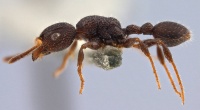Dilobocondyla oswini
| Dilobocondyla oswini | |
|---|---|

| |
| Scientific classification | |
| Kingdom: | Animalia |
| Phylum: | Arthropoda |
| Class: | Insecta |
| Order: | Hymenoptera |
| Family: | Formicidae |
| Subfamily: | Myrmicinae |
| Tribe: | Crematogastrini |
| Genus: | Dilobocondyla |
| Species: | D. oswini |
| Binomial name | |
| Dilobocondyla oswini Zettel & Bruckner, 2013 | |
Nothing is known about the biology of Dilobocondyla oswini.
Identification
Zettel and Bruckner (2013) - Worker: Blackish brown; scape yellow. Head with slightly angular posterior corners and almost straight posterior margin. Frontal carinae weak, posteriorly not stronger than other rugae. Clypeus with 2 - 5 longitudinal rugae. Microsculpture of clypeus, mesosoma, and petiole less developed than on frons and tergite 1; mesosoma slightly shiny. Meso- and metapleura with irregular vermiculated rugae. Petiole relatively stout, PtI 177 - 180.
This species is very distinctive from all described Philippine species. However, Dilobocondyla sp. 1 (sensu General & Alpert 2012) is closely related and can be separated by the sculptural characteristics given in the key. Dilobocondyla borneensis Wheeler, 1916, a species described from Mt. Bongo, Sarawak, Borneo (Wheeler 1916), has a similar structure of head and mesosoma, but a much coarser sculpture. In addition, the petiole of this and some other Dilobocondyla species from the southeast Asian mainland is more slender, similar as in the Dilobocondyla chapmani species group.
Keys including this Species
Distribution
Latitudinal Distribution Pattern
Latitudinal Range: 8.15° to 8.15°.
| North Temperate |
North Subtropical |
Tropical | South Subtropical |
South Temperate |
- Source: AntMaps
Distribution based on Regional Taxon Lists
Indo-Australian Region: Philippines (type locality).
Distribution based on AntMaps
Distribution based on AntWeb specimens
Check data from AntWeb
Countries Occupied
| Number of countries occupied by this species based on AntWiki Regional Taxon Lists. In general, fewer countries occupied indicates a narrower range, while more countries indicates a more widespread species. |

|
Estimated Abundance
| Relative abundance based on number of AntMaps records per species (this species within the purple bar). Fewer records (to the left) indicates a less abundant/encountered species while more records (to the right) indicates more abundant/encountered species. |

|
Biology
Castes
Nomenclature
The following information is derived from Barry Bolton's Online Catalogue of the Ants of the World.
- oswini. Dilobocondyla oswini Zettel & Bruckner, 2013: 146, figs. 5, 11, 17 (w.q.) PHILIPPINES (Mindanao I.).
- Type-material: holotype worker, 1 paratype worker, 1 paratype queen.
- Type-locality: holotype Philippines: Mindanao, Bukidnon, Malaybalay, Kaamulan, 650 m., 15-20.iii.2000, no. 247 (H. Zettel); paratypes with same data.
- Type-depositories: NMPM (holotype); HSZC (paratype).
- Status as species: Chen, et al. 2019: 138 (in key).
- Distribution: Philippines (Mindanao).
Unless otherwise noted the text for the remainder of this section is reported from the publication that includes the original description.
Description
Worker
Holotype: TL 4.44; HW 1.08; HL 1.09; CI 99; SL 0.70; SI 65; PnW 0.78; PtL 0.43; PtH 0.24; PtW 0.26; PtI 180; PpL 0.37; PpH 0.33; PpW 0.35. Paratype: TL 4.31; HW 1.06; HL 1.09; CI 97; SL 0.67; SI 63; PnW 0.77; PtL 0.46; PtH 0.26; PtW 0.25; PtI 177; PpL 0.34; PpH 0.33; PpW 0.36.
Colour: Body uniformly dark brown. Mandibles yellowish brown. Antennae chiefly brown; scape and base of funiculus yellow. Legs brown, except yellowish brown trochanters and bases of femora, and yellowish tarsi.
Structures: Head dorsally and on genae with almost regular longitudinal rugae and few interconnections, but rugae reticulated below and behind eyes. Interspaces matt, with dense micro-reticulum. Posterior margin of head almost straight, with weak concavity at middle, hind corners forming a sharp, but obtuse angle. Frontal carinae and antennal scrobes weakly developed behind eyes. Clypeus with two to five longitudinal rugae; interspaces weakly reticulated.
Mesosoma entirely reticulated; moderately developed rugae forming small meshes; an imaginary line between pronotal corners transecting twelve meshes; interspaces more or less shiny, with micro-punctures which are dorsally weakly developed and laterally hardly recognizable. Sculpture of petiole and postpetiole similar as on mesosoma, but slightly coarser on petiole and predominately longitudinal on dorsum of postpetiole. Dorsal outline of petiole almost regularly convex; anteroventral tooth relatively long and slender. Dorsal outline of postpetiole convex, highest point behind mid-length. Gaster tergite 1 almost entirely reticulated; basally with longitudinal striation that is distinctly shorter than length of longest seta on postpetiole.
Queen
TL 4.75; HW 1.07; HL 1.11; CI 96; SL 0.66; SI 62; PnW 0.85; PtL 0.47; PtH 0.26; PtW 0.28; PtI 181; PpL 0.40; PpH 0.34; PpW 0.38.
Colour, pilosity, and structures similar to worker. Head with three small ocelli. Mesosoma fully developed, its sculpture on the dorsal surface slightly coarser and more longitudinally orientated than in worker. Wings broken off.
Type Material
- Holotype, worker, Mindanao Island, Bukidnon Province, Malaybalay City, Kaamulan site, ca. 650 m a.sl., Philippines, 8°9′N 125°8′E / 8.15°N 125.133°E, 15-20 March 2000, H. Zettel, National Museum Manila.
- Paratype, 1 worker, 1 queen, Mindanao Island, Bukidnon Province, Malaybalay City, Kaamulan site, ca. 650 m a.sl., Philippines, 8°9′N 125°8′E / 8.15°N 125.133°E, 15-20 March 2000, H. Zettel, H. Zettel Collection.
Etymology
This species is dedicated to the second author’s brother.

